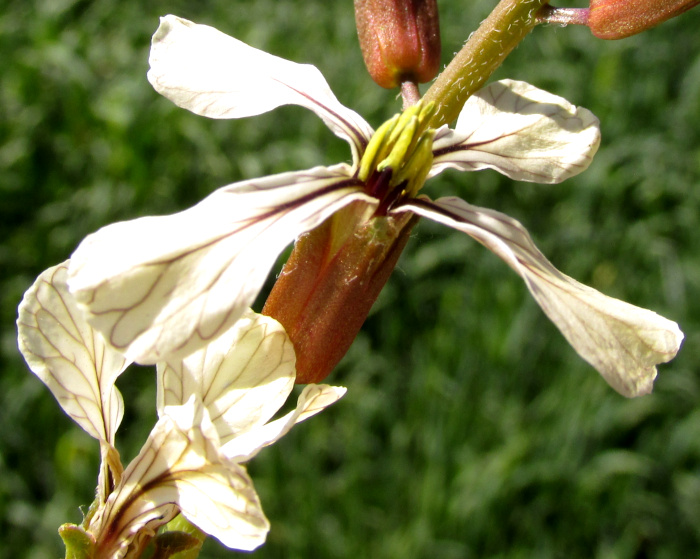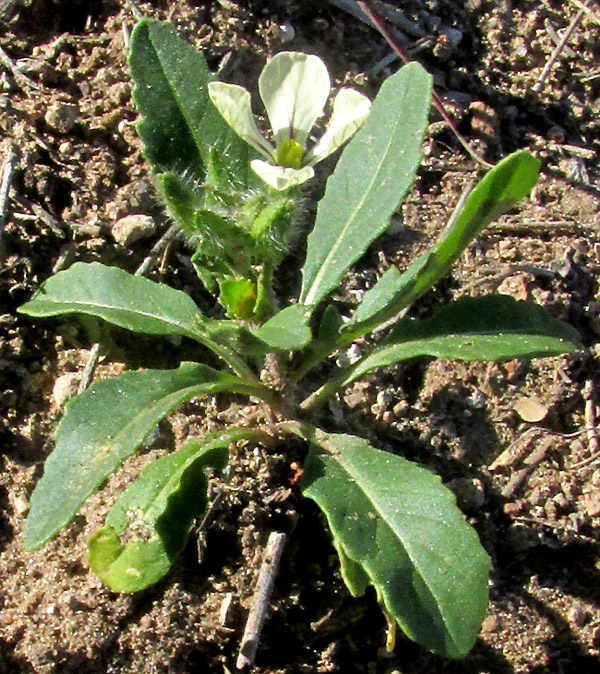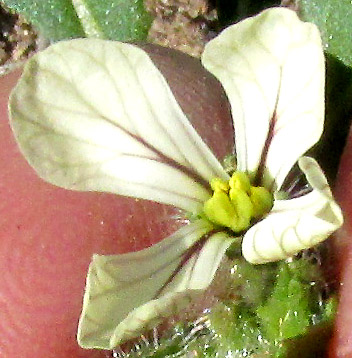Excerpts from Jim Conrad's
Naturalist Newsletter
entry from February 3, 2022, issued from near Tequisquiapan, elevation about 1,900m (6200 ft), N20.565°, W99.890°, Querétaro state, MÉXICO

ARUGULA/ ROQUETTE, AMAZING WEED
About half the agricultural fields in this area were abandoned to the weeds last season, for first a drought killed much of the crop, then a historic flood. Nowadays here and there irrigated, winter-planted crops form almost-shocking green patches in the otherwise brown/gray, mid-dry-season landscape. Moreover, since I arrived here last October, there's always been a certain white-flowered weed flowering in abandoned fields as well as the edges of irrigated ones, the one shown above at the margin of an irrigated field of oats.
With the general growth form, weedy habitat, and tender-looking flowers with four petals, it's easy to recognize as a member of the Mustard Family, the Brassicaceae. A close-up of the distinctive mustard blossom appears below:

The petals' purplish veins are a bit unusual. You can see that of the six stamens two are longer than the other four, exactly right for the Mustard Family. So are the silique-type fruits, shown below:

An important feature of these fruits is that their upper ends terminate in a flattish, sterile section in which ovules, later to become seeds, are not produced. The sterile sections are tipped with a hardly noticeable stigma, where pollen germinates. Finally, the leaves are also typically Mustard Family, shown below:

Surely the most surprising feature of this tough little weed is that its leaves taste so good. If you've enjoyed a good salad seasoned with what is variously called Arugula, Roquette, or any number of other common names, you've tasted it yourself. It's ERUCA VESICARIA ssp. SATIVA.
This tasty weed, especially rich in vitamin C and potassium, already was popular as an herb in ancient Roman times, not only for its good taste but also because it was considered an aphrodisiac. Having been planted and escaped in so many places for so long, it's hard to say where in the Old World the species is native, but now, as the Flora of North Americaauthors say, it populates "roadsides, disturbed areas, waste places, cultivated fields, dry ditches, rocky outcrops, gravelly slopes, sandy plains, open rangelands; 0-1200 m" pretty much worldwide, even Africa, Australia and Pacific Islands.
It's a good plant to know.
entry from January 3, 2024, issued from near Tequisquiapan, elevation about 1,900m (6200 ft), N20.565°, W99.890°, Querétaro state, MÉXICO
During the two years after the above entry was made this area has suffered an ongoing drought. Currently the North American Drought Monitor describes the current situation as a D3 Extreme Drought. Therefore, any plant currently able to flower in hard-compacted, sterile soil along a trail through the scrub can be said to be extraordinarily drought tolerant. That's the case with the plant below:


At first I didn't recognize it. Up close, the flower showed four petals and six stamens, of which two were shorter than the other four. The corolla's four petals not united with one another, and the six stamens with two short ones, suggested the Mustard Family, the Brassicaceae. However, still I couldn't recall having met something like this. Thinking about it, finally the field next to us was noticed:

That's an unirrigated field left unplanted for the last two years because of the drought. Nearly all the plants there are stunted Arugulas, but in soil not as dry and compacted as that of our one-flowered trailside plant. The aloe-like plants in the background are Magueys.
F. Steiner and A.M. Zuffo in their 2019 study " Drought tolerance of four vegetable crops during germination and initial seedling growth," confirmed the ability of Arugula's seeds to germinate and survive under drought conditions, though they may be stunted. They wrote, "Arugula and eggplant crops tolerate water stress of up to -0.2 MPa, without reducing germination of the seeds; however, the growth of shoots and roots are inhibited."